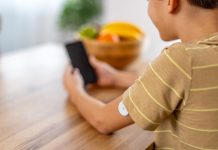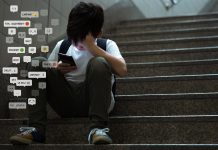Teaching children to foster safe and healthy relationships in social media environments is explored here by Marsali Hancock from the EP3 Foundation
Using social media is one of the most popular activities around the world. It allows society to be more connected than ever before. Digital 2020 reports show that digital, mobile, and social media have become an indispensable part of everyday life for people all over the world. Nearly 60% of the world’s population are already online. The latest trends suggest that more than half of the world’s total population will use social media by the middle of this year1 Regardless of what type of impact we believe these digital platforms can have on us, we must be intentional in how we use social media.2
In the United States, 5.7 million children under the age of 11 have accounts on Facebook, Instagram, and Snapchat–all of which have age restrictions that are intended to keep children from using them.3 Who is guiding these children and what are we doing to protect them? Can schools, parents, and community organisations provide digital and media literacy curriculum that improves behaviour? To answer these questions, the Center on Media and Child Health identify the key components of curricula that successfully teach children and youth digital the digital skills and competencies that foster healthy relationships and reduce online victimisation. Child health, wellness and media literacy experts reviewed several meta-analyses and individual studies to find the key elements required to teach children digital skills and competencies,4, 5 including social skills.
FIRST: Focus on the underlying issues
Research shows that effective Internet safety messages address the underlying issues that contribute to many of the known risky and anti-social behaviours on the Internet,6 rather than simply tell children to avoid problematic behaviours. Once the underlying issues are identified, then, help children build skills and competencies specifically addressing root causes. For example, children struggling to interact in positive ways online due to difficulty managing their anger can learn anger management techniques, rather than simply being told to be nice.
SECOND: Identify the problem and define the program logic
Outline the dynamics of the problem (i.e., understand what might cause it and where intervention might help), and then identify the research-supported prevention strategies to help address the problem: 1 Define the “research-based link between the problem, intervention, and prevention or reduction of the problem.”7
Here is an example: “A program targeting cyberbullying might begin by researching risk and causal factors related to bullying and cyberbullying (e.g., anger management problems, social pressure or positive feedback experienced by peers when engaging in bullying behaviours) and develop a program that uses evidence-supported strategies to improve these factors (teaching youth anger management skills or ways to handle social pressure to ‘join in’ with negative peer behaviours)…with the expectation that these strategies will reduce cyberbullying behaviours and increase positive bystander behaviours.”8
THIRD: Make is S.A.F.E: Incorporate proven, research-supported educational and prevention strategies
Effective risk prevention and social skills building9 curriculum follows the S.A.F.E. framework.
Sequenced: They break down complex skills into steps and help youth connect them.
Active: They provide basic instruction in a skill and then provide an opportunity to practice it.
Focused: They devote specific and sufficient time, effort, and attention to instruction.
Explicit: They clearly identify and share the skills that youth are expected to learn. The curriculum guide aims to incorporate all four of these attributes.
FOURTH: Evaluate outcomes
Where a curriculum is used, in-class assessment is necessary to determine whether students achieve the learning goals of each lesson. The only way to know the outcome of education initiatives is to invest the time and resources to assess, evaluate and peer review them. Don’t wait until after the program started before determining your measures of success. Build your evaluation and assessment alongside the curriculum. 10
An evaluation may include surveys completed by students, teachers, and parents before and after the entire curriculum is administered. Evaluators may also engage a control group, either in another classroom within the same school (if piloted in one class) or in another school (if it is implemented in an entire school). The control group takes the surveys at the same time points, but would not use the curriculum and outcomes compared.
Approach to developing example activities
Below are examples of research identified as effective (and fun) strategies for teaching children social, emotional and digital skills.
Role-playing: Role-playing is an effective means of practising skills.11 For role-plays, use training examples taken directly from the students’ learning environment, which can help students generalise their learning into other parts of their lives.12
Focus on situations that students may encounter now: To impact everyday life, role-plays must focus on conditions that the children are likely to face now, as opposed to those they may meet several years in the future. Children under the age of 10 typically do not use social media. There’s little evidence that teaching them directly about social media at this age translates into behaviour when using social media years later. Lessons geared toward this age group focus not on social media or direct online interaction, but rather on in-person (but often still media-related) situations. Role-plays for children older than 10 incorporate more elements of online interaction.
Bibliotherapy: Use books as tools to help youth work through complex social and emotional issues, such as bullying,13,14 social anxiety,15 and aggression.16 Specifically, bibliotherapy helps by presenting readers with literature (fiction or non-fiction) that may resemble their real-world problems. By following the characters and analysing the scenarios within the literature, the reader can gain insight into their own problems. Bibliotherapy can be a collaborative effort, allowing teachers, school counsellors, librarians, and administrators to “evaluate student writings and note personal, academic, social, and behaviour areas that need to be addressed.”17
“Digital Media are excellent tools for forging and maintaining healthy social relationships. As with all tools, how we use them determines whether they provide positive opportunities or expose us to risk. Media can either enhance relationships, supporting positive growth, or put users at risk.”18 The goal is to guide all children by building the skills they need to use media in ways that support healthy relationships.
Program logic
Aim to identify the problem, outline the dynamics of the problem (i.e., understand what might cause it and where intervention might help) and identify research-based prevention strategies to help address the issue.
Problem: Although online interactions can support and enhance relationships, they also have unique features that can negatively affect relationships in particular ways:
Perceived anonymity disconnects behaviour from consequences (e.g., seeing another child start to cry) and thus may allow them to behave more aggressively and say more hurtful things to others.19, 20
Infinite replicability and “stickiness” of images and text online mean that, even if they post something that they’d like to take back, it may already have spread to other people and can’t be deleted.
Children are engaging online but may not have the knowledge or skills to do so in ways that benefit and don’t harm their relationships. Thus, concern has emerged about how children manage relationships in that space. They may use it as a place where they can vent frustration or engage in confusing or difficult behaviours that they’ve witnessed or experienced elsewhere, as they do in offline contexts. Still, such actions online – whether cyberbullying or only making mean comments – may have more far-reaching consequences for their relationships.
The dynamics of the problem: There is evidence21 that children behave aggressively, both online and offline, as a way to express difficult emotions, such as anger, whether related or unrelated to the specific interaction in which they show it.
Prevention strategies to address the problem: Evidence22 suggests that learning strategies for managing emotions, both online and offline, can help solve the underlying problem. Being able to use these strategies effectively, as well as understanding that their behaviours may be hurtful to others, can support children in behaving in ways that more successfully support relationship health.
One of the skills that have been identified as necessary in a social skills curriculum shown to be effective with elementary school students is how to “work out strong feelings.” 23 Focusing your overall approach on teaching the skills to manage negative emotions, such as anger, online and offline.
In closing this in-depth analysis about teaching children to foster safe and healthy relationships in social media environments, let’s note that one more thing in relation to prevention strategies. Although many curricula focus on teaching children that the internet can never be entirely anonymous and that their behaviour does have consequences, with the assumption that knowledge will change their behaviour: that approach does not address their underlying reasons for behaving in those ways. Successful curricula address the issues that drive these behaviours and thus alter the root cause, which could have positive effects in many parts of their lives.
References
1 “Digital 2020: 3.8 billion people use social media – We Are Social.” https://wearesocial.com/blog/2020/01/digital-2020-3-8-billion-people-use-social-media. Accessed 26 Feb. 2020.
2 “How to Have a Healthy Relationship with Social Media ….” 25 Jul. 2019, https://www.columbiawell.org/blog/2019/7/25/how-to-have-a-healthy-relationship-with-social-media. Accessed 26 Feb. 2020.
3 “Digital 2020: 3.8 billion people use social media – We Are Social.” https://wearesocial.com/blog/2020/01/digital-2020-3-8-billion-people-use-social-media. Accessed 26 Feb. 2020.
4 “Evaluation of Internet Child Safety Materials Used by … – NCJRS.” https://www.ncjrs.gov/pdffiles1/nij/grants/242016.pdf. Accessed 26 Feb. 2020.
5 “(PDF) A Meta-Analysis of After-School Programs That Seek to ….” http://www.academia.edu/7381346/A_Meta-Analysis_of_After-School_Programs_That_Seek_to_Promote_Personal_and_Social_Skills_in_Children_and_Adolescents. Accessed 26 Feb. 2020.
6 “Evaluation of Internet Child Safety Materials Used by … – NCJRS.” https://www.ncjrs.gov/pdffiles1/nij/grants/242016.pdf. Accessed 27 Feb. 2020.
7 “Evaluation of Internet Child Safety Materials Used by … – NCJRS.” https://www.ncjrs.gov/pdffiles1/nij/grants/242016.pdf. Accessed 27 Feb. 2020.
8 “Evaluation of Internet Child Safety Materials Used by … – NCJRS.” https://www.ncjrs.gov/pdffiles1/nij/grants/242016.pdf. Accessed 27 Feb. 2020.
9 “The impact of enhancing students’ social and emotional learning.” https://www.ncbi.nlm.nih.gov/pubmed/21291449. Accessed 26 Feb. 2020.
10 “Evaluation of Internet Child Safety Materials Used by … – NCJRS.” https://www.ncjrs.gov/pdffiles1/nij/grants/242016.pdf. Accessed 27 Feb. 2020.
11 “Evaluation of Internet Child Safety Materials Used by … – NCJRS.” https://www.ncjrs.gov/pdffiles1/nij/grants/242016.pdf. Accessed 27 Feb. 2020.
12 “Conduct and Behavior Problems: Intervention and … – ERIC.” 2 Mar. 1998, https://files.eric.ed.gov/fulltext/ED519110.pdf. Accessed 27 Feb. 2020.
13 “StopBullying.gov.” https://www.stopbullying.gov/. Accessed 27 Feb. 2020.
14 “Using Literature as a Strategy to Promote Inclusivity in High ….” https://eric.ed.gov/?id=EJ955656. Accessed 27 Feb. 2020.
15 “Bibliotherapy Treatment for Children With Adjustment Difficulties.” https://www.researchgate.net/publication/233068405_Bibliotherapy_Treatment_for_Children_With_Adjustment_Difficulties_A_Comparison_of_Affective_and_Cognitive_Bibliotherapy. Accessed 27 Feb. 2020.
16 “Treating Child and Adolescent Aggression Through Bibliotherapy.” https://books.google.com/books?id=gEOcwdlATmoC&pg=PA228&lpg=PA228&dq=9.%09Shechtman+Z.+The+contribution+of+bibliotherapy+to+the+counseling+of+aggressive+boys.+Psychotherapy+Research.+2006;16(5):631-636.&source=bl&ots=wb-HmOZJ5I&sig=ACfU3U1vEpq4NZvSnlTYHR9fXqCs1oYYOQ&hl=en. Accessed 27 Feb. 2020.
17 “Treating Child and Adolescent Aggression Through Bibliotherapy.” https://books.google.com/books?id=gEOcwdlATmoC&pg=PA228&lpg=PA228&dq=9.+Shechtman+Z.+The+contribution+of+bibliotherapy+to+the+counseling+of+aggressive+boys.+Psychotherapy+Research.+2006;16(5):631-636.&source=bl&ots=wb-HmOZJ7J&sig=ACfU3U1pa_3Bqfeh0AdixAZLvo_sBzLE_w&hl=en. Accessed 27 Feb. 2020.
18 “How to Have a Healthy Relationship with Social Media | NAMI ….” 25 Feb. 2019, https://www.nami.org/Blogs/NAMI-Blog/February-2019/How-to-Have-a-Healthy-Relationship-with-Social-Media. Accessed 26 Feb. 2020.
19 “Online Communication Among Adolescents – Journal of ….” 13 Dec. 2010, https://www.jahonline.org/article/S1054-139X(10)00426-X/fulltext. Accessed 27 Feb. 2020.
20 “Online aggression: The influences of anonymity and social ….” https://psycnet.apa.org/record/2014-24373-001. Accessed 27 Feb. 2020.
21 “(PDF) The effects of anger management on children’s social ….” https://www.researchgate.net/publication/258189355_The_effects_of_anger_management_on_children’s_social_and_emotional_outcomes_A_meta-analysis. Accessed 27 Feb. 2020.
22 “(PDF) The effects of anger management on children’s social ….” https://www.researchgate.net/publication/258189355_The_effects_of_anger_management_on_children’s_social_and_emotional_outcomes_A_meta-analysis. Accessed 27 Feb. 2020.
23 “(PDF) The effects of anger management on children’s social ….” https://www.researchgate.net/publication/258189355_The_effects_of_anger_management_on_children’s_social_and_emotional_outcomes_A_meta-analysis. Accessed 27 Feb. 2020.
Please note: This is a commercial profile











